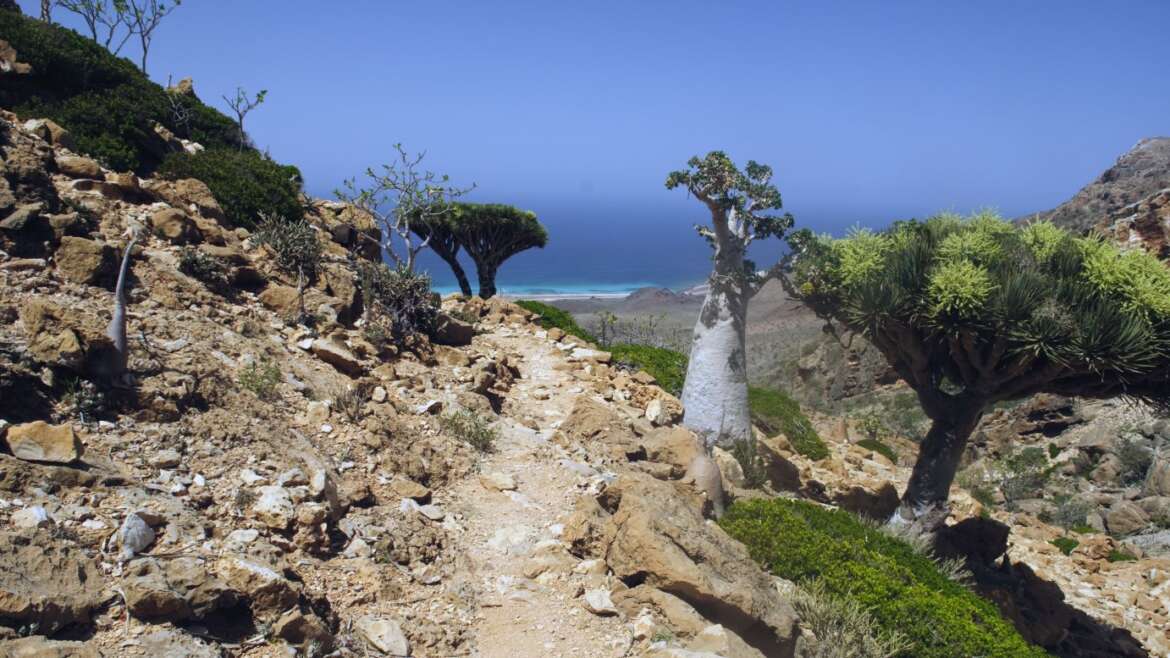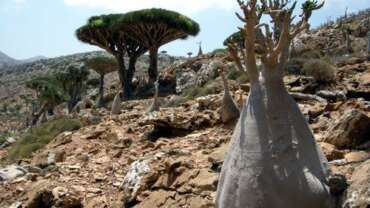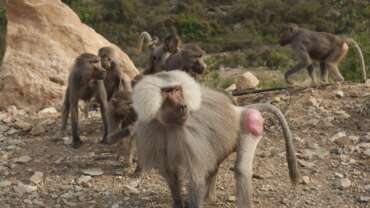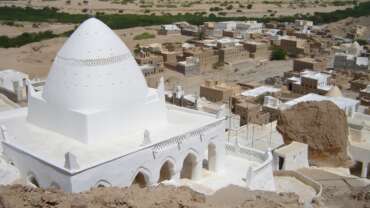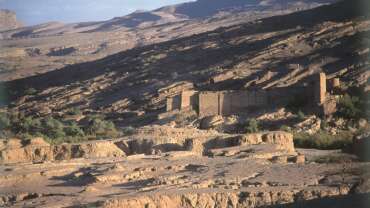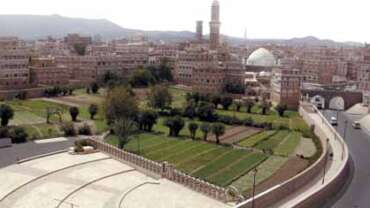Experiences in Yemen
Socotra
Socotra is one of Yemen’s greatest treasures of biodiversity. Located about 400km south of the mainland in the Indian Ocean, these arid islands play host to a stunning array of plant and animal life. An estimated 30% of the island chain’s plant life is endemic, as are many of the birds found there.
Socotra is an ecotourist’s dream – not all of the region’s animal species have been identified, and the waters surrounding the archipelago are relatively unexplored.
Flora: The plant life on Socotra is surprisingly diverse. There are over 900 known plant species on the island, a full 30% of which are endemic. Perhaps the most noteworthy of these is the dragon’s blood tree ( Dracaena cinnabari) The tree is so named for the bright red colour of its resin. The resin was a major export from the Island and a part of the spice trade of the region.
It was used as a varnish and dye, as an incense, and body oil. The dragon’s blood tree, which is identifiable by its unique umbrella shape, is found primarily in the mountain highlands of the island; these unique trees stand between 3m and 10m in height.
Also dwelling in the highlands are numerous shrubs, most prominently Rhus thyrsiflora, Cephalocroton soqotrans, and Allophylus rhoidiphyllus. Socotra aloes also occur in the higher altitudes.
At the foothills of the mountains of Socotra there is a rich shrub land. One of the most distinct plants in this area is the Socotra desert rose ( Adenium obesum ssp sokotranum).
This unique plant is also known as the “bottle tree” for its thick bottle-shape trunk. Other succulents in the area include the cucumber tree (Dendrosicyos socotrana) as well as both frankincense and myrrh.
Jatropha unicostata, which occurs on the lower slopes of the mountains, is prized for its medicinal uses.
On the plains and lowlands of the island the shrub Croton socotranus is the predominant flora. Also prevalent is the tree-euphorbia (Euphorbia arbuscula), which rises above the shorter shrubs.
Other plants of note are the Socotra begonia (Begonia Socotrana) and the Punica protopunica, a relative of the pomegranate, and the Persian violet (Exacum affine).
Baraqish
The name Baraqish was according to a female dog. When the town was surrounded by invaders and it was difficult to conquer the town, there was a secret tunnel leading to a well and the dog Baragish went through that tunnel for water and the invaders noticed that and controlled the well and the people of the town could not hold on without water and had to surrender. The original name was Yathol. Dated back to around the 10th BC, it is the most impressive archaeological site and best preserved ancient walled town in Yemen. It once had more than fifty towers and two gates, and its walls reached up to 14m high. Lying in the wide WadiFardha, it was previously known as Yathil, the dominant town in the Minaeen kingdom and an important centre for the incense trade.
The Sabaeans had controlled this whole region but by the end of the great Sabaean era in 410 BC. Main broke away and formed an alliance with Hadramout to open up new caravan routes and thus increase trade.
We know that the tales of royal towns and palaces in Arabia, the Emperor Augustus instructed the proconsul of Egypt, Aelius Gallus, to invade the peninsula and seize the wealth of the citadels of which he had heard so much. In 24 BC a force of 10.000 Romans and 15.000 mercenaries was assembled and sent to the region with Nabataean Marib.
The force never got back to the Mediterranean and the sea, however, once they had understood the pattern of the monsoons. In the main area of the site, there stand, the remains of a dome, a mosque, a well and tower amidst great shreds of pottery and glass.
Elsewhere an Italian archaeological team has recently excavated a temple which still had its roof and contained stone tables equipped with bull’s heads at the end. These may have been for sacrifices; the temple is thought to be to a god of healing.
Horse and camel racing
It is one an old favorite sports for Arabs and of course Yemen, as Yemen the origin of Arabs. The traditional horse racing is one of the Qarnaw festival events and this event considered the first in the Yemeni desert, Horse Racing.
It is one of the old favorite sports for Arabs and of course Yemen, as Yemen the origin of Arabs. The traditional horse racing is one of the Qarnaw festival events and this event considered the first in the Yemeni desert, and there are plans to establish a “Desert Marathon” for horse and knights soon where competitors has to pass 42.2 km. The winners in the current race will be awarded as well the long race of 80 km.
Camel Racing
It’s considered and interesting sport and loved by Arabs for hundreds of years as it’s the heritage, genuine and speed sport. will be fixed in someone’s mind the scene of group of camels race with a high speed that shake the ground tremendously. The camels participating in this event are three categories: 1-Al Sudais 2- Al Thanaya 3- Al Jadeea’
Grand Mosque
The Grand Mosque in Sana’a one of the most important mosques, not just in Yemen but in the whole Islamic world. This historic building is believed to have been first constructed during the life of the Prophet Muhammad (peace be upon him) in the 6th year A.H. The mosque was built upon the site of the Ghumdan Palace, between the two areas of Sana’a, Al-Quati and Al-Sailah. The city’s souq was moved next to the mosque, affording it with greater safety because of its proximity to a religious building. Along with the mosque, the palace site also houses a prison and barracks for the armed forces, built during the Ottoman Empire.
In later years, city planning, expansion and orientation were greatly influenced by the construction of the Great Mosque and two other mosques on the city’s north side. Though there are more than one hundred mosques in the Old City, the Grand Mosque is the largest and most notable of them.
The Grand Mosque in Sana’a one of the most important mosques, not just in Yemen but in the whole Islamic world. This historic building is believed to have been first constructed during the life of the Prophet Muhammad (peace and blessings be upon him) in the 6th year A.H.
It is considered to be among the world’s earliest mosques (the third, to precise), preceded only by the Qa’ba Mosque and the Prophet’s Mosque in Madina.
The mosque is known for its wooden ceilings which are covered with a profusion of decorations that reflect the attention Muslim rulers paid to construction and renovation activities.
The ceiling of the mosque was not always the same; it used to be encircled in a wooden wraparound on which inscriptions from the Quran and the Prophet’s traditions were written in Kufi script.
As for the wooden panels, they ar decorated with three styles; the first style seems to reflect the Umayyad era, represented in convolvulus branches of plants from which protrude the acanthus or grape leaves and bunches or pinecones, in addition to pearls.
The second style reflects the Abbasid era dating back to Al Ya’afar reign, featuring the style of Samara and arabesque.
The third style features decorative elements that appeared during the 12th century A.D. such as the star plate, the egg and the arrow decorations.
The mosque has a rectangular shape of 78×65 meters. The exterior walls of the mosque were built from basalt which is locally known as “al habash”.
It can be accessed through 12 gates, and has an open courtyard flanked by porticos from all directions. The mosque has two minarets, one of which is set over the mosque’s nave and the other inside the western side. Two libraries have also been built as annexes to the mosque, on its right and its left. Dormitories were later added to shelter the poor and students.



